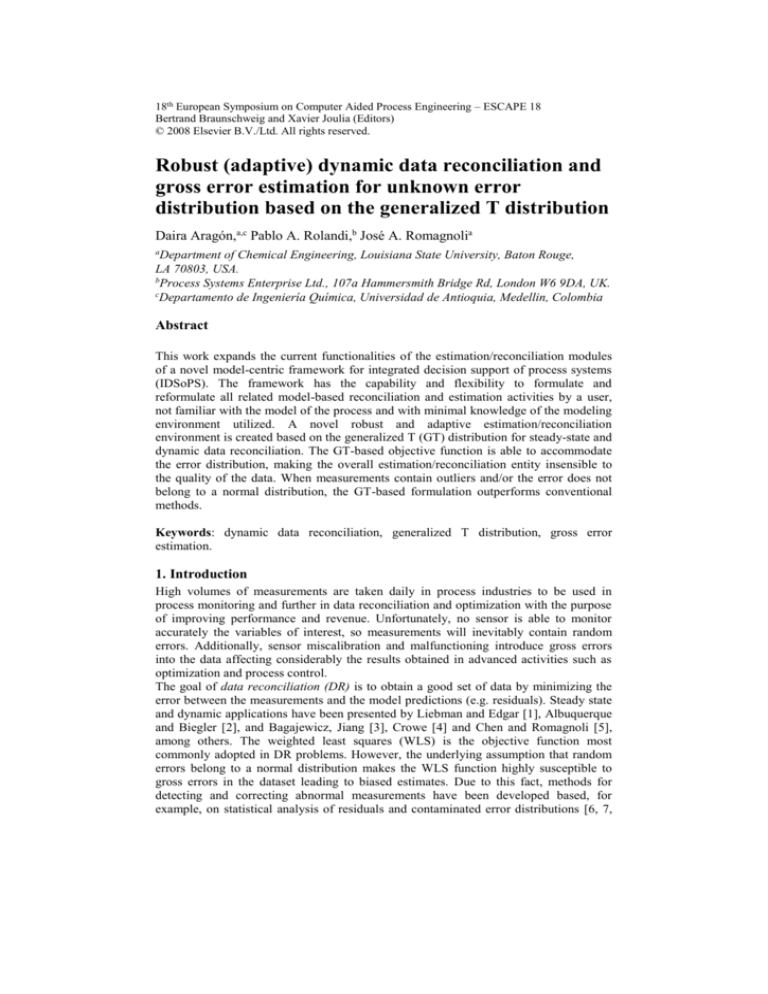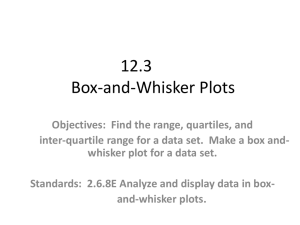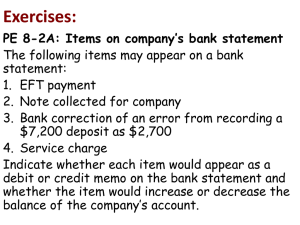
18th European Symposium on Computer Aided Process Engineering – ESCAPE 18
Bertrand Braunschweig and Xavier Joulia (Editors)
© 2008 Elsevier B.V./Ltd. All rights reserved.
Robust (adaptive) dynamic data reconciliation and
gross error estimation for unknown error
distribution based on the generalized T distribution
Daira Aragón,a,c Pablo A. Rolandi,b José A. Romagnolia
a
Department of Chemical Engineering, Louisiana State University, Baton Rouge,
LA 70803, USA.
b
Process Systems Enterprise Ltd., 107a Hammersmith Bridge Rd, London W6 9DA, UK.
c
Departamento de Ingeniería Química, Universidad de Antioquia, Medellin, Colombia
Abstract
This work expands the current functionalities of the estimation/reconciliation modules
of a novel model-centric framework for integrated decision support of process systems
(IDSoPS). The framework has the capability and flexibility to formulate and
reformulate all related model-based reconciliation and estimation activities by a user,
not familiar with the model of the process and with minimal knowledge of the modeling
environment utilized. A novel robust and adaptive estimation/reconciliation
environment is created based on the generalized T (GT) distribution for steady-state and
dynamic data reconciliation. The GT-based objective function is able to accommodate
the error distribution, making the overall estimation/reconciliation entity insensible to
the quality of the data. When measurements contain outliers and/or the error does not
belong to a normal distribution, the GT-based formulation outperforms conventional
methods.
Keywords: dynamic data reconciliation, generalized T distribution, gross error
estimation.
1. Introduction
High volumes of measurements are taken daily in process industries to be used in
process monitoring and further in data reconciliation and optimization with the purpose
of improving performance and revenue. Unfortunately, no sensor is able to monitor
accurately the variables of interest, so measurements will inevitably contain random
errors. Additionally, sensor miscalibration and malfunctioning introduce gross errors
into the data affecting considerably the results obtained in advanced activities such as
optimization and process control.
The goal of data reconciliation (DR) is to obtain a good set of data by minimizing the
error between the measurements and the model predictions (e.g. residuals). Steady state
and dynamic applications have been presented by Liebman and Edgar [1], Albuquerque
and Biegler [2], and Bagajewicz, Jiang [3], Crowe [4] and Chen and Romagnoli [5],
among others. The weighted least squares (WLS) is the objective function most
commonly adopted in DR problems. However, the underlying assumption that random
errors belong to a normal distribution makes the WLS function highly susceptible to
gross errors in the dataset leading to biased estimates. Due to this fact, methods for
detecting and correcting abnormal measurements have been developed based, for
example, on statistical analysis of residuals and contaminated error distributions [6, 7,
2
D. Aragon et al.
8]. Most of these methods continue to require specific assumptions on the statistical
distribution of the errors, usually assumed to be known, which represents a major
drawback considering that true values, and consequently errors, are not known in real
processes. In this work, a generalized T distribution [9] is used to obtain a robust
objective function for dynamic data reconciliation. With the appropriate selection of the
GT parameters or, alternatively, using nonparametric probability density function
estimation, the shape of the error distribution can be adjusted prior to or during the
reconciliation procedure, making the GT-based formulation insensitive to outliers and
applicable when no knowledge exists about the distribution of the measurement errors.
This work expands the current functionalities of the estimation/reconciliation modules
of a novel model-centric framework for integrated decision support of process systems
(IDSoPS) with the capability and flexibility to formulate all related model-based
reconciliation and estimation activities by a user, not familiar with the model of the
process and with minimal knowledge of the modeling environment utilized [10, 11]. A
novel robust and adaptive estimation/reconciliation environment is created based on the
GT distribution for steady-state and dynamic data reconciliation. The GT-based
formulation is implemented within the IDSoPS and compared with the contaminated
distribution-based formulation and the traditional weighted least squares. The results
clearly illustrate that the GT robust formulation has the capability to determine the error
distribution, to reconcile highly nonlinear dynamic processes, and to be insensitive to
outliers outperforming other conventional approaches.
This paper is organized as follows. Section 2 gives an overview of the different errors
encountered in process measurements; then, it presents a general formulation for
dynamic data reconciliation showing how errors are treated and last, it discusses a new
approach based on the generalized T distribution for robust dynamic data reconciliation.
In section 3, a simulation case study is presented and the results are analyzed. Finally,
some conclusions are drawn in chapter 4.
2. Framework for robust data reconciliation
2.1. Error classification
Process measurements inherently contain errors. In the classification adopted in this
work, errors are divided in two categories: random errors and gross errors. Random
errors are inherent to the sensor being used and are small in magnitude relative to the
measurement value. On the other hand, gross errors are defined as abnormal
observations present in a dataset and are classified as systematic errors or “biases” and
outliers. Biases are generally related to miscalibration of instruments and are presented,
in the simplest case, as a consistently high or low value over time for a specific sensor
in dynamic systems. Outliers are associated to sensor malfunctioning and unaccounted
disturbances and, in dynamic systems, are manifested only at one particular time (i.e. a
spike).
Usually, activities such as optimization and process control make use of fundamental
conservation equations in conjunction with plant data. However, because of the
presence of errors, measurements are unlikely to satisfy the mass and energy balances
and therefore, must be adjusted before the execution of any model-based activity,
performing, for example, data reconciliation. A proposed general formulation for the
reconciliation problem and its treatment of errors are explained next.
2.2. Dynamic data reconciliation (DDR)
Data reconciliation refers to the estimation of process measurements through the
minimization of the error between the measurements and the model predictions (e.g.
Robust (adaptive) dynamic data reconciliation and gross error estimation for unknown
error distribution based on the generalized T distribution
3
residuals). Note that only redundant measurements, those for which enough spatial or
temporal information is available, can be reconciled. Spatial redundancy relates to the
existence of relations among the process (i.e. model) variables; while temporal
redundancy refers to the availability of past measurements. Dynamic data reconciliation
takes advantage of both spatial and temporal redundancies. In this work, we propose the
following general mathematical definition for the estimation/reconciliation problem:
min
z , , , , ,
(~z (t ), z (t ), (t ), (t ))
(1)
s.t.:
F ( x (t ), x(t ), y(t ), u(t ), ) 0
(2)
subsetx(0), y(0) x0 , y0
(3)
~
z (t ) z(t ) (t )
(4)
(t ) (~z (t ), , )
(5)
(t ) ( (t ), (t ))
(6)
In the previous formulation, (t) represents a generic objective function. The decision
variables of the general estimation problem are the vectors , , , and . These
parametric variables correspond to different features of the overall mathematical model,
are model parameters to be estimated; , and are associated with the statistical
information about the experimental observations, the two former define the intrinsic
variance model, (t), while the latter characterizes the shape of the error distribution as
it will be discussed later. Depending on the nature of (t), (t) can be either the
variance of the measurement errors or the weight of individual variables within this
multivariable objective function. Finally, systematic errors in measurements, , are
included in the formulation and explicitly defined in the sensor equation (Eq.(4)) which
relates the discrete experimental observations, ~
z (t ) , with reconciled trajectories, z(t),
systematic error, and random errors, (t). Random errors as given in Eq.(6) include
all parameters which characterizes their statistical distribution. Eq.(2) and Eq.(3) denote
the set of partial differential-algebraic equations encompassing the fundamental process
model and the set of initial conditions respectively. In these equations x and y represent
the differential and algebraic variables respectively, and u(t) the set of input variables.
Since a dynamic process is continuous in nature, the reconciliation problem is reduced
to a finite-dimensional mathematical problem through the discretization of the input
variables.
Over the years, weighted least squares (WLS) has been the most common objective
function employed in data reconciliation. However, its poor performance in the
presence of outliers requires the reduction of this type of errors. Approaches such as the
global, nodal and measurement tests did not include the presence of outliers into the
objective function [6], and therefore, they are required of additional procedures (e.g.
statistical test and repetition of the reconciliation) to obtain final estimates. Throughout
the years, new objective functions have been developed to take into account the
presence of outliers in the measurement data directly in the objective function without
4
D. Aragon et al.
considerably affecting the final estimates, this is known as robust data reconciliation. In
this work, we propose to use a generalized T distribution [9] to perform robust dynamic
data reconciliation in the presence of outliers and systematic errors. Results are
compared with those obtained utilizing a bivariate objective function based on a
contaminated Gaussian distribution.
2.2.1. The contaminated Gaussian-based objective function
The bivariate objective function shown in Eq.(7) was initially introduced for steady
state data reconciliation by Tjoa and Biegler [8]. Studies have shown that the
contaminated Gaussian-based objective function presents better performance than the
least squares method [13].
m
ln (1 ) exp 0.5 2 2
i 1
m
exp 0.5 2 2 b 2 ln
b
i 1
(7)
The parameters and b are included in the function to represent the probability of
outliers in the data and the relative magnitude of outliers to random errors. In Eq.(7), m
corresponds to the number of measurements, to the residuals standard deviation and
to the random errors. The presence of outliers can be confirmed by a posteriori analysis
of the residuals.
2.2.2. The generalized T distribution-based objective function
The symmetric and unimodal generalized T (GT) distribution is described by the
probability density function:
f ( ; , p, q)
p
p
1/ q
2q B(1 p , q) 1
q p
q 1 / p
(8)
The parameters , p and q define the distribution. While is associated with dispersion,
p and q give the shape of the distribution. B represents the beta function and represents
the residuals. Initially used in regression problems, this density has the characteristic of
defining a broad family of distributions, including the normal distribution (p=2, q),
t-distribution (p=2) and Cauchy distribution (p=2, q=0.5) among others. Larger values
of p and q represent thinner tails.
The -function of the GT distribution is given by the natural log of f(u;, p, q). The
redescending pattern of the influence function or -function in Eq.(9) suggests that it
will be insensible to outliers, that is large values of the residuals .
( ; , p, q)
( pq 1) sign( )
q
p
p
p 1
(9)
An M-estimator constructed from the influence function of Eq.(9), was successfully
applied to steady state data reconciliation [12]. In this work, the robust M-estimator is
extended to dynamic data reconciliation as Eq.(10) indicates.
tc
max
z
n
ln
k t 0 i 1
f ( ik ; i , p, q )
(10)
Robust (adaptive) dynamic data reconciliation and gross error estimation for unknown
error distribution based on the generalized T distribution
5
t0 and tc represent the initial and current time respectively; n is the total number of
measurements and z represent the reconciled values. The distributional parameters p and
q (and possibly ) can be estimated adaptively by two methods. In the first option the
parameters are considered as a decision variables in the optimization process. The
second method which maximizes the likelihood function evaluated at the residuals of
initial state estimates was adopted in this work.
3. Case study
3.1. Process description
The case study considered here consists of an integrated plant of two CSTRs in series
and fresh feed mixing with the outlet stream of the first reactor before entering the
second vessel [14, 15]. The model was constructed in gPROMS and a simulation was
run for a total of 7.5 hours to obtain 75 experimental values. Once the plant was at
steady state, a step change in the feed temperature was introduced at 1.5 hours to obtain
a dynamic response. This original data set was modified by adding errors from normal,
t- and exponential distributions to all variables so that new data sets were formed. Also,
additive outliers were incorporated to the data set with normal error distribution. Then,
additional data sets were measurement bias (systematic errors) to an output flow rate.
3.2. Results and discussion
Dynamic data reconciliation (DDR) was performed for the sets described previously,
using three different objectives functions: weighted least squares (WLS), the one based
on the contaminated normal (CN) distribution, and the one based on the generalized t
(GT) distribution. Results for DDR were obtained using the sequential solution
approach available in gPROMS. This involves state-and-sensitivity integration of the
augmented model-plus-sensitivity system followed by solution of a finite-dimensional
NLP, in an iterative fashion (SQP-NLP).
The values of the mean squared error (MSE) and total error reduction (TER) for the
three objectives functions considered in the absence of systematic errors are presented
in Table 1 (TER values are shown in parenthesis). The results suggest that there are not
significant differences in the performance of the three methods when the residuals
belong to a normal distribution and no outliers are present. However, the GT-based
objective function displays its superiority over WLS and CN when outliers are present
or the residuals belong to different distributions. In fact, the values of p and q obtained
were 2 and 100 in the absence of outliers (normal and t-distributions), 2 and 50 with
outliers, and 1 and 50 for residuals from an exponential distribution. Clearly, the
objective function has accommodated the shape of the error distribution, with lower
value of q for thicker tails. Fig. 1 presents the MSE results without outliers for easier
visualization.
Table 1: MSE results for dynamic data reconciliation of integrated plant of two CSTRs
Error distribution
No outliers
Normal
Outliers
t-distribution
Exponential distribution
WLS
4.59 (0.969)
70.72 (0.589)
19.91 (0.142)
10.40 (0.992)
CN
4.06 (0.973)
59.02 (0.657)
16.08 (0.307)
10.18 (0.992)
GT
4.05 (0.973)
8.27 (0.952)
8.37 (0.639)
6.44 (0.994)
In a second analysis, the presence of systematic errors was evaluated. For this purpose,
a bias of -0.639 was incorporated to an output flow rate measurement for the dataset
containing t-distributed residuals.
6
D. Aragon et al.
25
WLS
CN
GT
MSE
20
15
10
5
0
Normal
t
exponential
Error distribution
Figure 1: TER results for different objective functions and error distributions. Left: in absence of
outliers. Right: with outliers.
The results presented in table 2 indicate that biases are estimated accurately with no
significant differences among the objective functions. Although all three methods show
deterioration on the MSE values, the objective function based on the GT distribution
continues to display better results.
Table 2: Bias estimates and MSE values for dynamic data reconciliation of integrated plant
Objective function
WLSQ
CN
GT
Estimated bias
(true value = -0.639)
-0.696
-0.694
-0.695
MSE
20.06
20.52
19.89
4. Conclusions
Objectives functions based on the contaminated normal distribution (CN) and on the
generalized t (GT) distribution were implemented for robust dynamic data reconciliation
within a single and consistent model-centric framework for integrated decision support
of process systems (IDSoPS). Results indicate that the GT-based objective function
outperforms the CN and the least squares when errors deviate from normality and/or
outliers are present in the measurement set. The incorporation of online capabilities and
methodologies for analysis of redundancy in nonlinear dynamic systems are currently
under study.
References
[1] M.J. Liebman, T.F. Edgar, L.S. Lasdon, 1992, Comp. Chem. Eng., 16, 963.
[2] J.S. Albuquerque and L.T. Biegler, 1996, AIChE J., 42, 2841.
[3] M.J. Bagajewicz and Q. Jiang, 2000, Comp. Chem. Eng., 24, 2367.
[4] C.M. Crowe, 1996, J. Proc. Control, 6, 89.
[5] J. Chen and J.A. Romagnoli, 1998, Comp. Chem. Eng., 22, 559.
[6] A.C. Tamhane and R.S.H. Mah, 1985, Technometrics, 27, 409.
[7] I. Kim, M.S. Kano, S. Park and T.F. Edgar, 1997, Comp. Chem. Eng., 21, 775.
[8] I.B. Tjoa and L.T. Biegler, 1991, Comp. Chem. Eng., 15, 679.
[9] J.B. McDonald and K.N. Whitney, 1988, Econometric theory, 4, 428.
[10] P.A. Rolandi and J.A. Romagnoli, 2005, AIChE annual meeting, Cincinnati, USA.
[11] D. Aragon, P.A. Rolandi and J.A. Romagnoli, 2006, AIChE annual meeting, San Francisco,
USA.
[12] D. Wang and J.A. Romagnoli, 2003, Ind. Eng. Chem. Res., 42, 3075.
[13] D.B. Özyurt and R.W. Pike, 2004, Comp. Chem. Eng., 28, 381.
[14] P.A. Bahri, J.A. Bandoni and J.A. Romagnoli, 1996, AIChE J., 42, 4, 983.
[15] J.A. Romagnoli and M.C. Sánchez. Data processing and reconciliation for chemical
operations, San Diego, California, United States, 2000.







